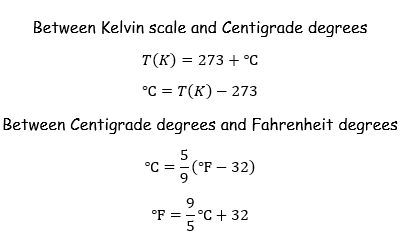Join Our Groups
TOPIC 8: TEMPERATURE

Concept of Temperature
The Term Temperature
Define the term temperature
Temperature is property of a body, which decides which way heat will flow when it is placed in contact with another body.
Temperature is defined as the degree of hotness or coldness of a body. It is the one of the factors which make scientists to determine the amount of heat energy possessed by a body.
The SI Unit of Temperature
State the SI unit of temperature
The SI unit of temperature is Kelvin (K). Kelvin scale is known as absolute temperature scale or thermodynamic scale. The lowest temperature in kelvin scale is 0K known as Absolute zero.
Commonly in thermometers we encounter the unit Celsius degree (0C) another scale is called Fahrenheit scale.
Conversion between temperature scales.
The values of temperature can be converted into different units by using specific formulae as below;

Measurement of Temperature
Measurable Physical Properties that Change with Temperature
Identify measurable physical properties that change with temperature
A reliable measurement of temperature is done by a thermometer. Thermometers use measurable physical properties that change linearly with temperature to give temperature reading.
Physical properties that change with temperature are called thermometric properties of a thermometer which include the following:
- Expansion of liquid when heated. E.g. Alcohol and mercury
- Expansion of strip of two metals.
- Generation of an electric current when heated
- Change in resistance of a wire
The Fundamental Interval of a Thermometer
Define the fundamental interval of a thermometer
When you want to construct a thermometer you must establish two constant temperatures called fixed points. The fundamental interval of thermometer is the difference between the upper fixed point and lower fixed points.
The lower fixed point is the temperature of pure melting ice while the upper fixed point is the temperature of the boiling water. Therefore lower fixed point is referred to as the ice point and the upper fixed point is referred to as the steam point.
Since water freeze at 0 degrees centigrade and boils at 100 degrees of centigrade, it follows that the lower and upper fixed points are 00C and 1000C respectively.
The Mode of Action of Liquid-in-glass Thermometer
Describe the 'mode' of action of liquid-in-glass thermometer
The working of this type of thermometer is based on the fact that liquid expands when heated and contracts when cooled. Examples of Liquid in glass thermometers are mercury and alcohol thermometers.
These two thermometers are called
- Mercury in glass thermometer
- Alcohol in glass thermometer
These thermometers have bulbs, which are reservoirs of liquid, and stems with fine bodies through which liquid rises and falls during the variation of temperatures.
The liquid used in these thermometer types is called thermometric liquids. A thermometric liquid is the one which show significant changes with the change in temperature and hence used in thermometers. A thermometric liquid must be very sensitive to temperature changes.
Comparison between the thermometric liquids:
| Mercury | Alcohol |
| i. It is good conductor of heat | i.It is fairly a good conductor of heat. |
| ii. It expands linearly | ii. It expands rapidly |
| iii. It is clearly seen | iii. It is colourless |
| iv. It boils at 3600c | iv. It boils at 780c |
| v. It freezes at 390c | v. It freezes at – 1120c |
| vi. It does not wet a glass | vi. It wets the glass |
Why water is not used as a thermometric liquid
Even though water is very readily available and it is cheap compared to mercury or alcohol, it is not used as thermometric liquid because:
- Its volume expansion is not linear
- It wets the glass
- It has high heat capacity
The Temperature of a Body
Measure accurately the temperature of a body
The temperature of the human body is measured by a special kind of mercury thermometer known as clinical thermometer. It has a large bulb, thin tube to make it sensitive to temperature changes of human body. The tube of the clinical thermometer has a constriction necessary for preventing the back flow of mercury after the thermometer has been removed from the human body.
A clinical thermometer is a typically a mercury in glass thermometer used to measure human body temperature. As the temperature rises the mercury expands and flows up the capillary tube. However, clinical thermometers have some limitations, they are delicate and can break easily, they may spread infection if not properly sterilised and they do not necessarily reflect the core body temperature.






EmoticonEmoticon